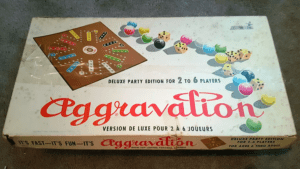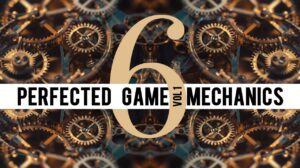This is the description of the game Aggravation on BoardGameGeek:
Players move their four pieces around the board from start to home. Lucky die rollers can make use of the shortcut spaces to speed movement. However, players can not pass their own pieces and landing on any one else’s piece sends the landed-on piece back to the base where it must start again. First player to get all four pieces home wins.
Other than explaining that the game uses one six-sided die, going over the rules for moving a piece from the base area to the main board, and showing the reader a picture of the four-player board (standard version) and the six-player board (deluxe version), there really is little else to be said about how to play the game.
Aggravation came onto the market in 1962. Does it hold up to today’s standards?

In our Back in the Day articles revisiting classic experiences, we won’t discuss how to play these games…they are old, and if you want to learn how to play, feel free to search the ‘net for answers. We’ll instead focus on what still works, and what doesn’t, while making a recommendation on whether you need to dig this one out of your attic or not!
Personal History
Back in the early 1970s, when I was but a wee lad, my mother would invite neighbors over to play Aggravation. In retrospect, the game itself served little purpose other than to anchor the group to the table as they had loud conversations and drank too much.

There was a point at which the gatherings went from four to six after my mother picked up a copy of Deluxe Aggravation (sometimes called the Party Edition). The deluxe portion of that name came in the form of a board that could handle two more players and the addition of another shortcut option. Because, let’s face it, it was a bear trying to make your way all the way around that board!
For some reason, my mother always seemed to see Aggravation as an adult activity; we kids were not allowed to join in (too much alcohol?), and she never played this game with us when the neighbors were not there. She played games like Monopoly with us. My step-father would later introduce me to games like Win, Place & Show and Acquire. But Aggravation, for reasons I cannot fathom, remained something taboo.
When I was in my teen years, I was walking through a department store and spotted a copy of Aggravation on the shelf. Without thinking too much, I picked it up. To my dismay, this was a cheap and shoddy production. The copy my mother had those years earlier, had a nice, thick board with holes where the marbles would remain in place. This thing I had purchased did not come with a board in the box; instead, you had to punch perforated spots out of the back of the box, which served as the playing surface (for as long as those holes stayed together enough to support the marbles). That thing ended up in the trash.
Many years later, after I met my wife, LeAnne, I was informed that she and her parents had a New Years tradition of getting together with a couple they had known for years. They would go to dinner, go see a movie, then retire to one of their homes to play games for the evening. Since LeAnne and I were together, I was expected to come along. It was asked that I find a game that was easy to teach and play that could also handle six players.
I thought about this for a while that year and, considering the ages of her parents and this other couple, I wanted something that would feel familiar and be fairly light; something that would not impede the conversation as we played. When I thought of Aggravation, I knew I needed to find the deluxe version. I located one on eBay and ordered it with plenty of time to ensure that everything was in the box. When New Years rolled around, I brought it along and we all played several games together. They enjoyed it enough that I was asked to bring it the next year as well. We played Aggravation (and other games, like Scattergories) each New Year until COVID put a damper on our social calendar.
When my wife and I moved from Iowa to Maryland, our copy of Aggravation remained in the Midwest.
Aggravation: What Works
If you have played Aggravation, or any of the myriad variations on this theme (e.g., Parcheesi, Sorry, Trouble, ad astra) then you know that there is not much to it. It is a simple roll-and-move race game.
Players roll a die. If the die comes up on a number that allows you to move a marble from your base to the main board, that is an option. Otherwise, the decision space is reduced to looking at all your marbles on the board and checking to see if you can send an opponent’s marble back to their base. Barring that, you look to see if you can take advantage of any shortcuts (standard Aggravation has one shortcut path, Deluxe Aggravation has two). If none of these apply, then move a marble forward the number of spaces shown on the die. That truly is it.
Everything that works in this game boils down to aggravating your opponents. The laughter and groans that result from having a marble a couple of spaces away from home suddenly jolted back to the base is what makes the game enjoyable. At least for the player that did the aggravating.
Aggravation: What Doesn’t Work
What doesn’t work about the game is, well, everything else. The start of the game is excruciatingly slow as players have to wait until they can get a marble onto the main board before they can do anything. This has resulted in many people instituting a house rule that all players start with a marble on the main board at the start of the game. But no matter how you try to spice it up, each player will have long periods of time where they can literally do nothing. Turn after turn of rolling the die and having no legal moves. This happens a lot.
Another issue with this game is the feeling that you are being picked on. When another player lands on your piece and they had even one other legal move they could have made, less mature players will have a tendency to take this personally. Kids, when playing games of this ilk, often reach that board-flipping state.
Yea or Nay?
A little yea. A little nay.
If you have some older folks you want to sit down and play a board game with, Aggravation and others in this family of games is not a bad choice. I have seen some beautiful hand-made wooden boards for these marble games that come in all sorts of shapes and sizes. This means that today’s septuagenarian-plus population have likely seen and played games like this before. This might be the sort of thing to bring out some fond childhood memories.
If you have children that can handle the gotcha elements of a game like this, it might be a good choice as well. At most, however, I would suggest this as a game to introduce the idea of gotcha-type elements, then allow them to move on to other games with more agency.
For anyone else, I think this is the sort of game that just does not fit into the paradigm of modern board games. There are so many choices that are far, far better. Go grab a copy of Carcassonne or Codenames or what-have-you. If all else fails, grab a standard deck of playing cards; just about anything you do with those will be more entertaining (and less aggravating) than Aggravation.
The Back in the Day Series:











Add Comment